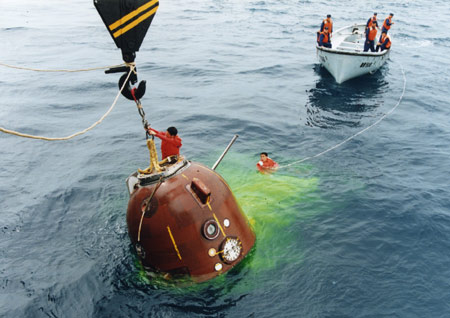Compared with Shenzhou VI, Shenzhou VII has "brighter eyes", "fewer wings" and a "longer body", Qin Wenbo, deputy chief commander of the launch program of the manned spacecraft, told the Xinhua News Agency Wednesday.
 |
|
Space center employees go through a recovery exercise at sea. [File Photo] |
The "eyes" refer to the two cameras added to the orbital and service modules, which will be used to make live broadcasts of Zhai Zhigang's spacewalk.
"The cameras had to overcome the challenges of weight and quality," Qin said, adding that they have been designed to work under extreme temperatures and in a vacuum.
The Shenzhou VII mission is the first to carry the maximum payload of three astronauts, so keeping weight down was also a top priority, he said.
One of the two pairs of solar panels used on Shenzhou VI has been dropped, and the total number of engines on the orbital module has been cut, he said.
"We have succeeded in producing the same power with fewer engines," he said.
As well as the task of losing weight, the development of the airlock module and extravehicular spacesuits were key challenges for China's space scientists, Qin said.
The airlock is a pressure chamber that links the main body of the spacecraft to the outside, and is key element of the spacewalk, he said.
The astronauts who venture outside the spacecraft will do so in specially designed suits that weigh more than 120 kg. The suits worn by astronauts on the Shenzhou VI mission weighed just 10 kg, Qin said.
The heavier suits provide the astronauts with additional protection, by replicating the Earth's atmosphere and providing oxygen, removing carbon dioxide and controlling the temperature, the deputy chief commander said.
A report in yesterday's Guangzhou-based New Express quoted Zheng Yonghuang, deputy chief engineer of the launch team, as saying that comparing the Shenzhou VI with Shenzhou VII spacecraft was like comparing a Volkswagen Santana with a BMW.
(China Daily September 25, 2008)